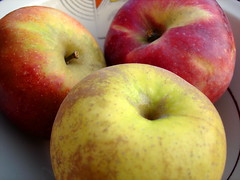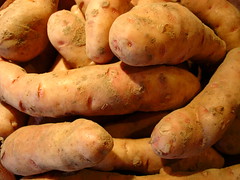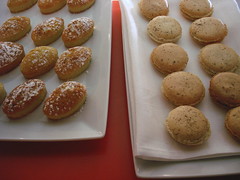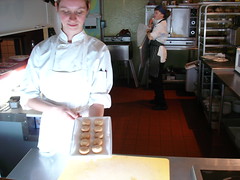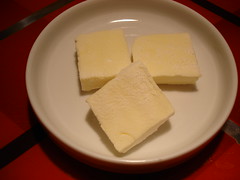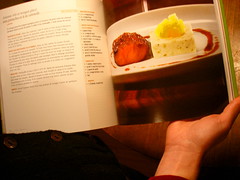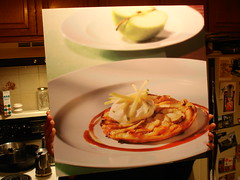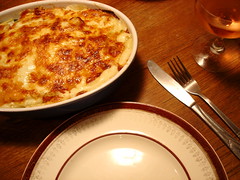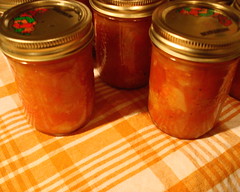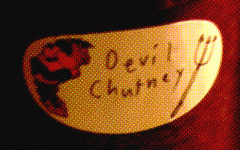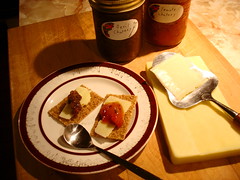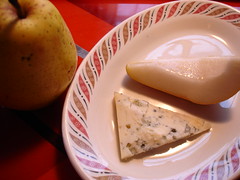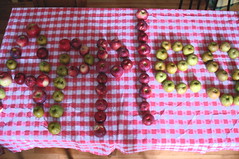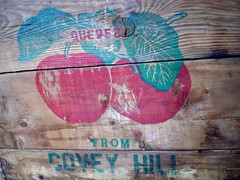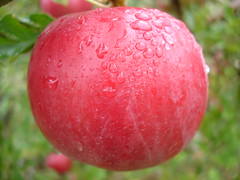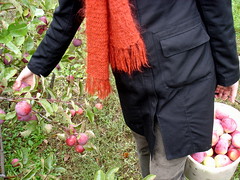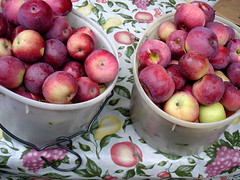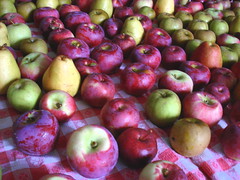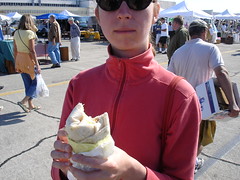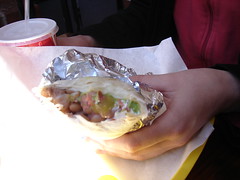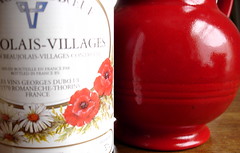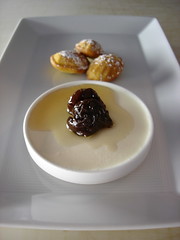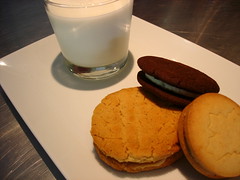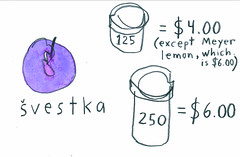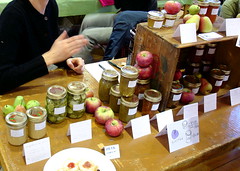pommes/pommes de terre
As indicated in our last post, and as confirmed by the photo above, our apple kick definitely isn't over. Hell, we're even contemplating going back to Franklin for Round 2.
Anyway, today we had a conversation with Adam about why we got in this food blog racket in the first place. We're just about to hit our first anniversary, so this is something we've been giving some thought to over the last little while, and something I'm sure we'll be writing about when we hit that milestone. What I can tell you at present, though, is that there've been a number of surprises (pleasant ones) that have fallen into our laps over the last 12 months because of "...an endless banquet," and our friend Adam's visit today was representative of just how pleasant these surprises can be. We knew Adam was heading down to New York and possibly even New Hampshire to do some research on a book he's been working on on the topic of fruit, and we knew he was planning on hitting a couple of very interesting sounding apple orchards. We'd even put in a request for a few prime specimens, but we had no idea if he'd actually be able to come back with anything, and what he'd be able to come back with if he managed to bring anything back. Needless to say, we were pretty excited when we got a phone call from Adam announcing that he'd come back to Montreal with treats for us, excited to see just what he had in store for us. You see, Adam had an appointment to visit the U.S. germplasm repository for apples in Geneva, NY. This wasn't just any old orchard, it wasn't even a first-rate orchard like Red Jacket (also in Geneva), this was a "living museum" of the apple, an apple "library," a collection of apple trees that numbered 5,000 and that encompassed some 2,500 varieties. The germplasm depository had been created in the mid-19th century as a kind of Noachian attempt to preserve and document the 1,800-odd varieties of apple available in the U.S. at the time, as well as to ensure the future development of apple varieties. It's an endeavor that appears to have succeeded. Adam biked over this afternoon, we sat down at our kitchen table, and he told us about his tour of the repository and everything he'd seen. Then he gave us the assortment of apples, mostly heirlooms, that he'd brought back for us: two court-pendus, a rare French variety, a russett-golden delicious hybrid, a Cox's orange pippin, a Monroe, a big, firm variety developed in the more recent past, a jonah gold, and--get this--an Esopus Spitzenberg, another rare variety native to the U.S. that dates back to at least the early 19th century. As I'm sure you've been able to tell over the last few weeks, dear readers, we love our apples. Few things make us happier than an assortment of rare apples, especially when they're as beautiful as these ones. We've been warned that most of them might not necessarily be the best eating apples, but there's also a magic to just coming across strange types of apple you never would have imagined existed (like the court-pendus).
Similarly, a week ago we got a completely unexpected visit from our friend Patrice Fortier, the gardener/farmer who runs the wondrous La Société des Plantes in Kamouraska. We knew he was in town, because he'd emailed me to let me know he was going to be around and that he was going to try to stage one of his informal vegetable & herb street sales, but then we didn't hear back from him. The last thing we were expecting was that he would show up at our doorstep, bearing freshly dug up heirloom fingerling potatoes no less.
It was a Friday evening and I was just getting home from work. We sat in the dining room, had a beer and some Haldiram's All In One, caught up, talked about life at La Société des Plantes, picked out our potatoes, traded some pear-vanilla-bourbon butter for some of Patrice's delicious persillade, a pesto made with parsley, garlic, and sunflower seeds, and generally got the weekend started right. After a couple of hours, Patrice headed out the door to meet up with another friend, and we rolled up our sleeves and prepared our dinner. We turned up the music and found ourselves in the best mood. It's hard enough to get fingerling potatoes in Montreal (although there are signs that that situation is improving). Getting them delivered to your door and turning their delivery into an excuse for an impromptu Happy Hour is beyond ideal. Patrice is due back in town in the next week or so, and he's promised to come laden with white carrots, white beets, Brussels sprouts, potatoes, herbs, and other specialties. If he organizes a street sale, we'll be sure to let you know.
Like I said, these little surprises aren't the reason we started "...an endless banquet," but they're certainly one of the reasons we've enjoyed working on "...an endless banquet" over the last year and are looking forward to year 2.
aj
